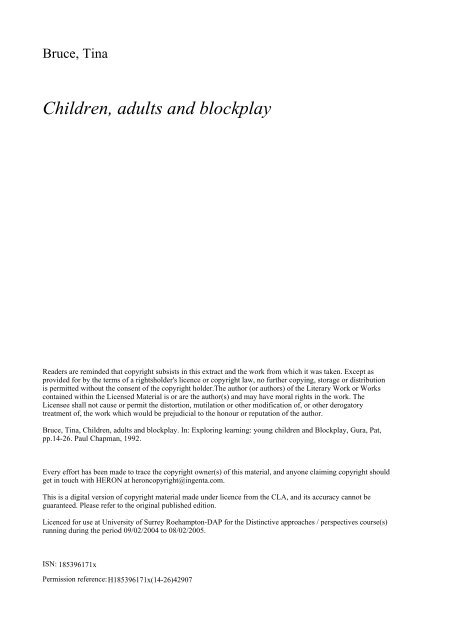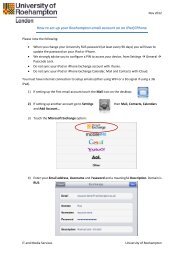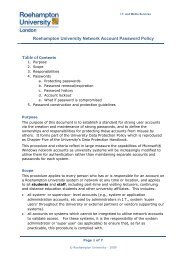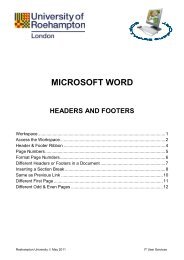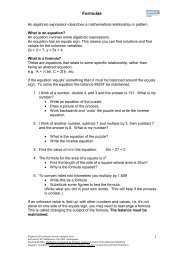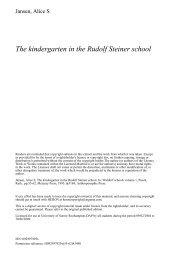Children, adults and blockplay - StudentZone - Roehampton
Children, adults and blockplay - StudentZone - Roehampton
Children, adults and blockplay - StudentZone - Roehampton
You also want an ePaper? Increase the reach of your titles
YUMPU automatically turns print PDFs into web optimized ePapers that Google loves.
Bruce, Tina<br />
<strong>Children</strong>, <strong>adults</strong> <strong>and</strong> <strong>blockplay</strong><br />
Readers are reminded that copyright subsists in this extract <strong>and</strong> the work from which it was taken. Except as<br />
provided for by the terms of a rightsholder's licence or copyright law, no further copying, storage or distribution<br />
is permitted without the consent of the copyright holder.The author (or authors) of the Literary Work or Works<br />
contained within the Licensed Material is or are the author(s) <strong>and</strong> may have moral rights in the work. The<br />
Licensee shall not cause or permit the distortion, mutilation or other modification of, or other derogatory<br />
treatment of, the work which would be prejudicial to the honour or reputation of the author.<br />
Bruce, Tina, <strong>Children</strong>, <strong>adults</strong> <strong>and</strong> <strong>blockplay</strong>. In: Exploring learning: young children <strong>and</strong> Blockplay, Gura, Pat,<br />
pp.14-26. Paul Chapman, 1992.<br />
Every effort has been made to trace the copyright owner(s) of this material, <strong>and</strong> anyone claiming copyright should<br />
get in touch with HERON at heroncopyright@ingenta.com.<br />
This is a digital version of copyright material made under licence from the CLA, <strong>and</strong> its accuracy cannot be<br />
guaranteed. Please refer to the original published edition.<br />
Licenced for use at University of Surrey <strong>Roehampton</strong>-DAP for the Distinctive approaches / perspectives course(s)<br />
running during the period 09/02/2004 to 08/02/2005.<br />
ISN:<br />
185396171x<br />
Permission reference: H185396171x(14-26)42907
2<br />
CHILDREN, ADULTS AND<br />
BLOCKPLAY<br />
Tina Bruce<br />
INTRODUCTION<br />
Western societies tend to value that which is measurable <strong>and</strong> part of the<br />
tangible experiences of life. It might be of crucial importance for the devel-<br />
opment of humanity if more emphasis were to be placed on what could be,<br />
ought to be, <strong>and</strong> on alternative, imagined worlds (Meek, 1985). The way <strong>adults</strong><br />
<strong>and</strong> children use blocks together will either help or hold back this process.<br />
THE THREE APPROACHES OF THE RESEARCH<br />
PROPOSAL AND THE BASELINE SURVEY<br />
The research proposal aimed to look at approaches to the curriculum that<br />
might be laissez-faire, didactic or interactionist (see Appendix I). Initially, a<br />
baseline survey was carried out by each school in order to establish how blocks<br />
were being used.<br />
LAISSEZ-FAIRE<br />
The baseline survey revealed that current practice <strong>and</strong> organization of<br />
<strong>blockplay</strong> tended to be unintentionally laissez-faire. That is to say, it was not<br />
the policy of any of the schools. In practice, the block area was set up but not<br />
necessarily all the time, <strong>and</strong> children were often left to use blocks without<br />
<strong>adults</strong>.<br />
Presentation<br />
The presentation of blocks may have had an impact in that children seemed<br />
to be held at an early level of <strong>blockplay</strong>. During sessions, the block area
<strong>Children</strong>, Adults <strong>and</strong> Blockplay 15<br />
became increasingly uninviting, as blocks became scattered. The baseline<br />
survey revealed that schools did not possess complete sets of unit blocks, or<br />
that children removed blocks from the set <strong>and</strong> transported them elsewhere.<br />
Typically the schools offered children blocks mixed with other media. These<br />
included play people, train sets, cars, etc.<br />
This led to discussion about what constitutes order or mess in a classroom.<br />
The unintended laissez-faire approach seemed to lead to children ab<strong>and</strong>oning<br />
the <strong>blockplay</strong> area once it became too untidy. Consequently, <strong>blockplay</strong> was<br />
often effectively over by 10 a.m.<br />
Timetabling<br />
Timetabling was important. If the school offered initially only indoor play,<br />
with the option from 10 a.m. of playing outside, there seemed to be a mass<br />
ab<strong>and</strong>onment of other activity. The blocks particularly often suffered from<br />
such an arrangement, as children would be expected to tidy up before leaving<br />
the block area. In contrast to putting away pencils, clearing up might appear<br />
to the child as a penalty to be paid for playing with the blocks. In fact, one<br />
child was overheard telling her friend not to use too many blocks ‘because you<br />
have to put them away afterwards’.<br />
Process <strong>and</strong> Product in Blockplay<br />
The group also began to realize from the collection of baseline data that there<br />
was virtually no regard for product in the <strong>blockplay</strong>. Bruner (1976) argues that<br />
both process <strong>and</strong> product are important. Some children tended to knock down<br />
any end-products, causing their creators to leave the area in a state of resig-<br />
nation, or upset <strong>and</strong> frustrated. In reality, only the children who dominated the<br />
<strong>blockplay</strong> were in a position to build constructions that stood any chance of<br />
remaining for any length of time, without threat of demolition. Demolition<br />
is one of the joys of <strong>blockplay</strong>, <strong>and</strong> one way or another will be part of it.<br />
However, an unintended laissez-faire approach encourages demolition in<br />
particular ways, which may not be the most educationally desirable.<br />
As the group reflected on this, it became clear that this situation was not<br />
what participants saw as ideal. Participants had joined the project in order to<br />
explore such issues together. There was great interest in the picture that began<br />
to emerge, <strong>and</strong> commitment to developing practice from this point.<br />
From unintended laissez-faire beginnings, the group moved towards the<br />
exploration of interactionist strategies. The act of observing <strong>and</strong> recording<br />
<strong>blockplay</strong>, which had become a regular adult activity, served as a bridge<br />
between non-involvement <strong>and</strong> positive interaction. The energy of the par-<br />
ticipants went into consideration of the role of the adult in <strong>blockplay</strong>, which<br />
also had an impact on the curriculum in general. Participants shared an im-<br />
plicit respect for the laissez-faire approach in its reticence to invade <strong>and</strong><br />
dominate children’s play.
16 Exploring Learning: Young <strong>Children</strong> <strong>and</strong> Blockplay<br />
DIDACTIC<br />
As the discussion developed, anxiety was expressed that almost before they<br />
knew it, <strong>adults</strong> would find themselves dominating. Such studies as that of Wells<br />
(1987) indicate that <strong>adults</strong> do indeed tend to take over, <strong>and</strong> become didactic<br />
when they join children’s play. This is also noted by Hutt et al. (1988, p. 227):<br />
‘More often than not <strong>adults</strong>, in interacting with either a single child or a small<br />
group of children, tend to dominate the interaction.’<br />
The didactic approach emphasizes tasks set by <strong>adults</strong>. Adult-directed tasks<br />
encourage dependency, narrowness, a desire to please those in authority,<br />
conformity <strong>and</strong> a lack of creativity, imagination or the ability to create <strong>and</strong><br />
solve problems. It leads to the need to feel secure through sticking to what is<br />
known <strong>and</strong> understood, rather than risk-taking <strong>and</strong> exploration (Dweck <strong>and</strong><br />
Legett, 1988).<br />
The didactic approach was never explored as the result of my decision as<br />
director of the project. The didactic approach brought us all great unease, <strong>and</strong><br />
did not sit easily beside the initial training of either teachers or nursery nurses.<br />
It did not fit with the current research <strong>and</strong> theory the group was exploring,<br />
either on general inservice courses or in the <strong>blockplay</strong> project. Transmitting<br />
knowledge about how to build a tower, etc., through demonstration, or<br />
stipulating what children are to construct (e.g. a house) or setting specific<br />
construction tasks, would have undervalued research that pointed to the need<br />
for children to initiate, to be active in their learning, to make decisions <strong>and</strong><br />
choices, to negotiate, to set their own problems <strong>and</strong> to problem-solve with help<br />
where needed.<br />
The group’s discussions moved from unintended laissez-faire to interactionist<br />
strategies.<br />
INTERACTIONIST<br />
The participants in the <strong>blockplay</strong> project worked in a determined way to<br />
develop strategies that would help children’s <strong>blockplay</strong> to develop with quality.<br />
This meant that <strong>adults</strong> needed to find more helpful ways than didactic ap-<br />
proaches offer in giving children information, or making suggestions about<br />
what they might do: ‘A little technical help given when the children have<br />
shown that they cannot solve the problem themselves may be necessary,<br />
particularly in some bridging constructions or when making a roof for an<br />
enclosure’ (Parry, 1978, p. 10).<br />
<strong>Children</strong> sometimes meet difficulties they cannot resolve alone. There are<br />
times when they need information <strong>and</strong> help in finding strategies that enable<br />
them to carry out an idea. At other times they are able to solve their problems<br />
without adult help. This would include collaborative learning through <strong>and</strong> with<br />
friends, using books, paying focused attention to the medium, manipulating
<strong>Children</strong>, Adults <strong>and</strong> Blockplay 17<br />
<strong>and</strong> exploring it, remembering what the material will do from previous oc-<br />
casions or learning through watching. The children have appreciated the<br />
appropriate <strong>and</strong> sensitive strategies <strong>adults</strong> in the project worked hard to<br />
achieve. It makes children want <strong>adults</strong> with them, <strong>and</strong> there has been great<br />
development in the richness of the <strong>blockplay</strong>. One participant commented in<br />
her notes towards the end of the project ‘At every stage we’ve really had to go<br />
back to basics <strong>and</strong> sort out our own thinking before we move forward’.<br />
STRATEGIES DEVELOPED USING THE<br />
INTERACTIONIST APPROACH<br />
The Role of Adults<br />
<strong>Children</strong> find it easier to play if they are helped <strong>and</strong> encouraged to do so<br />
by <strong>adults</strong>: ‘If there is one single message which comes through . . . it is the<br />
importance of the caring adult both in directing the child’s play in an appro-<br />
priate way at the appropriate moment, <strong>and</strong> in gauging the child’s mood state<br />
<strong>and</strong> deciding in which circumstances it is inappropriate to intervene’ (Hutt<br />
et al., 1988, p. 194).<br />
<strong>Children</strong> need to play alone, <strong>and</strong> they need to play in groups, <strong>and</strong> one of the<br />
most powerful ways to become involved in rich play is through partnerships<br />
(Sylva et al., 1980). <strong>Children</strong> develop these with other children; hence the<br />
crucial importance for young children of who is <strong>and</strong> who is not their best<br />
friend.<br />
An adult joined two girls at the point where a block construction had been<br />
completed. She wondered how it was done, tried <strong>and</strong> failed to make a similar<br />
construction. The girls explained ‘You need a friend’. They gave a demon-<br />
stration. One held the block while her friend arranged the other blocks against<br />
it so that they would balance as a whole (Figure 4.14).<br />
<strong>Children</strong> also develop play partnerships with <strong>adults</strong> if given the opportunity.<br />
The Froebel Blockplay Project gave great emphasis to adult–child play<br />
partnering.<br />
A Team Approach to Blockplay<br />
Initially, <strong>adults</strong> tried a very gentle approach. Attention was given to classroom<br />
organization <strong>and</strong> presentation. This involved <strong>adults</strong> planning together who<br />
would be in the block area <strong>and</strong> when. It meant looking at where the block area<br />
should be, <strong>and</strong> having a distinct block area. It meant considering the space<br />
available for <strong>blockplay</strong>, offering it indoors <strong>and</strong> outdoors where possible, <strong>and</strong><br />
considering how to make it available <strong>and</strong> when. Ideally, it was felt that<br />
<strong>blockplay</strong> should be available all the time.
18 Exploring Learning: Young <strong>Children</strong> <strong>and</strong> Blockplay<br />
Gender Issues<br />
A marked gender influence was at work to begin with, with boys tending to<br />
form groups <strong>and</strong> take over the <strong>blockplay</strong> area. This meant that many children<br />
were prevented from moving beyond their starting strategies – watching, on the<br />
edge, or repeating what they did last time. The dominating group had the<br />
effect of pushing them to the periphery with few blocks for their use. This lack<br />
of space <strong>and</strong> lack of materials constrained development of <strong>blockplay</strong> for<br />
children not in the dominant group.<br />
A girl <strong>and</strong> boy collaborated in the making of a house for Cinderella <strong>and</strong><br />
Prince Charming to live in after they married. There is space to sunbathe on the<br />
roof. It is important to note that the story, which became an ‘alternative’ to<br />
Cinderella (a tale of dreams turned sour) was improvised as the building<br />
progressed. A dynamic relationship developed between the kind of construction<br />
that emerged <strong>and</strong> the plot of the story. The <strong>adults</strong>’ role was to be interested <strong>and</strong><br />
to act as a sensitive audience to the unfolding story. The boy <strong>and</strong> the girl worked<br />
co-operatively, neither dominating, <strong>and</strong> each contributing.<br />
Encouraging <strong>Children</strong> to Use the Block Area<br />
Some children were never in the block area to be observed. In her notes, the<br />
research assistant describes how she initiated <strong>blockplay</strong> through the strategy of<br />
storying, so that children began to watch the <strong>blockplay</strong>, join in with it or take it<br />
over. Some children were not finding out what blocks were like because they<br />
never used them.<br />
Play partnering can be initiated <strong>and</strong> led by <strong>adults</strong>, as in this case, or by<br />
children. Sometimes the adult leads, <strong>and</strong> sometimes the child leads (Bruce,<br />
1987). Two girls were partners in their <strong>blockplay</strong>:<br />
A says ‘Let’s build’. B says ‘Yes’. They build a pile. Pat, the adult, says ‘I’ve<br />
got a family. Here’s me.’ (One cylinder.) ‘Here’s my husb<strong>and</strong>.’ (Another<br />
cylinder.) ‘And here’s my children, Lucy <strong>and</strong> Mark.’ (Another two cylinders.)<br />
‘And here’s my cat.’ (An eighth unit.) ‘We need a house.’ A says ‘We’ll build<br />
you a house’. During the tidying of the blocks, she heard B saying ‘Be careful of<br />
Patti’s cat’. In her h<strong>and</strong> she had an eighth unit <strong>and</strong> was stroking it, <strong>and</strong> said<br />
‘We’ll wait until all the blocks are away <strong>and</strong> then we’ll put it in (with the others).<br />
We don’t want it to get hurt, do we?’<br />
In this example, the children took over the story the adult used as a strategy<br />
to get things off the ground when help was first needed.<br />
Encouraging Adults to Be in the Block Area<br />
There are many ways for <strong>adults</strong> to join the block area without dominating.<br />
Some <strong>adults</strong> tried a side-by-side strategy, as in the Cinderella example. That is<br />
to say, <strong>adults</strong> joined children in the block area but were aware of the tendency<br />
to dominate <strong>and</strong> so did not initiate a conversation. They watched children.
<strong>Children</strong>, Adults <strong>and</strong> Blockplay 19<br />
They listened to what children said. They were participant observers, simply<br />
showing interest (Corsaro, 1979).<br />
<strong>Children</strong> Need Help<br />
Observations highlighted that children might first be attracted to the area<br />
because of its presentation but then be at a loss to know how to use it, not yet<br />
knowing the possibilities of <strong>blockplay</strong>. <strong>Children</strong> cannot easily plan how to use<br />
an area they do not yet know much about. They tend to build the same things<br />
each time, perhaps in order to feel secure, or perhaps to get to know the<br />
material. They might stay on the edge of the area, watching <strong>and</strong> performing<br />
very simple actions, apparently uninvolved. It may be that these are simply<br />
sensible starting strategies for children to adopt. What emerges from the<br />
<strong>blockplay</strong> project is just how sensible children are.<br />
Acting on Observations<br />
Adults either waited for children to say something or made a remark or<br />
movement with the blocks attempting to connect with what they had seen the<br />
child do or say. There are links here with Goetz’s (1981) research, who<br />
emphasizes the importance of praising children when they make a new form<br />
out of blocks <strong>and</strong> actually pointing out to them that they have made something<br />
different <strong>and</strong> new. The manner in which this is done forms part of the ethos of<br />
the setting: being warm, attentive, enthusiastic <strong>and</strong> sensitive is of fundamental<br />
importance. In this way, the adult’s first move into conscious play partnering<br />
was to join in with what they thought children were doing. Bruner et al. (1976)<br />
says we need to observe in order to diagnose the ‘incipient intention’ of the<br />
child.<br />
Adults began to report girls joining the block area, <strong>and</strong> boys being more<br />
willing to share. <strong>Children</strong> were developing effective strategies for working<br />
together, as in the Cinderella construction, <strong>and</strong> side by side. <strong>Children</strong> were<br />
gaining mastery of blocks <strong>and</strong> using them in increasingly complex symbolic<br />
play. Again, in the Cinderella construction, the children wanted to build a<br />
staircase on the side of the building. This was difficult, <strong>and</strong> so they talked<br />
about having a chute that could be a fire escape, which was simpler to make.<br />
This linked with the work of Wolf <strong>and</strong> Gardner (1978, p. 118), who define<br />
symbolic play as ‘the ability to represent actual or imagined experiences<br />
through the combined use of small objects, motions <strong>and</strong> language’. Blockplay<br />
lends itself to this.<br />
Respecting <strong>and</strong> Enabling <strong>Children</strong>’s Ideas<br />
Wynne Harlen <strong>and</strong> Paul Black (1989), investigating the effective teaching of<br />
primary science in the National Curriculum, note:
20 Exploring Learning: Young <strong>Children</strong> <strong>and</strong> Blockplay<br />
systematic observation of children’s ideas has shown that if these are ignored <strong>and</strong><br />
children are expected to accept the ‘right’ answer, then only confusion results.<br />
<strong>Children</strong> retain their initial ideas because it is these which they will have worked out<br />
for themselves, <strong>and</strong> which, for the moment, make sense to them in terms of their<br />
experience <strong>and</strong> their logic. These are the ideas which children use in trying to<br />
underst<strong>and</strong> new phenomena as their experience exp<strong>and</strong>s.<br />
There are parallels between this approach <strong>and</strong> that of the Froebel Blockplay<br />
Project. Harlen <strong>and</strong> Black emphasize that it is time to have the courage of our<br />
convictions. They point out that in reality, few opportunities are given for<br />
children to express their ideas. Pat Gura (personal communication) points out<br />
that after Guanella <strong>and</strong> Johnson’s studies in the 1930s there is a gap of some<br />
thirty years before studies of spontaneous <strong>blockplay</strong> reappear.<br />
The <strong>blockplay</strong> project, looking at the 3–7-year-old level, takes up Froebel’s<br />
statement that we need to ‘begin where the learner is’.<br />
The laissez-faire approach tends to leave children where they are. The<br />
didactic approach gives children only the ‘right’ ideas. The interactionist<br />
approach begins where children are, helping them to use what they know, <strong>and</strong><br />
to move with them into new knowledge <strong>and</strong> underst<strong>and</strong>ing. In order to do this<br />
in an interactionist way, <strong>adults</strong> need to know as much as possible about the<br />
development of young children, <strong>and</strong> the context of learning. They also need to<br />
be clear about what they are helping children to know <strong>and</strong> underst<strong>and</strong>, as with<br />
two boys who were constructing separately but near to one another. They used<br />
all the basic block forms as they played <strong>and</strong> seemed to be going over<br />
everything they knew about their mastery of blocks. It seemed to be a<br />
celebration of their knowledge <strong>and</strong> mastery of blocks. The contribution of the<br />
sensitive, interested <strong>and</strong> skilled adult is indirect on the whole, but at times<br />
<strong>adults</strong> also need to take a direct role, otherwise (as the <strong>blockplay</strong> project<br />
found) the children’s play is less rich.<br />
THE IMPORTANCE OF ACTION<br />
So far we have looked at interactionist strategies that encourage both children<br />
<strong>and</strong> <strong>adults</strong> to use the block area to good effect. We have seen that this enables<br />
the development of materials mastery, which enables rich play to develop.<br />
Hutt et al. (1989, p. 231) distinguish between open-ended, transparent struc-<br />
turing <strong>and</strong> closed, opaque structuring, which constrains the child’s activity,<br />
often in counterproductive ways. What becomes clear is that children need<br />
many opportunities to master, control <strong>and</strong> become competent in their block-<br />
play. They need to explore the potential of blocks <strong>and</strong> what can be done with<br />
them, alongside developing ideas through them. In this way, they reach the<br />
point where they not only have ideas about the possibilities of blocks <strong>and</strong><br />
can represent events <strong>and</strong> experiences with them but they can also carry out<br />
these ideas effectively <strong>and</strong> to their own satisfaction.
<strong>Children</strong>, Adults <strong>and</strong> Blockplay 21<br />
A girl (4y.) is making a freest<strong>and</strong>ing enclosure. She is using her knowledge of<br />
how to make right angles with blocks (Figure 5.4).<br />
Materials mastery has a central place in <strong>blockplay</strong>. Materials mastery<br />
involves aspects of knowledge <strong>and</strong> underst<strong>and</strong>ing that form the bedrock on<br />
which the possibility of advance planning, acting on a plan or reflecting on<br />
it rest. After all, a good worker knows the tools <strong>and</strong>, through this active<br />
knowledge, learns about their potential. <strong>Children</strong> need to know about blocks,<br />
<strong>and</strong> so come to envisage what blocks will do. Forman (1982) sees the early<br />
manipulation of blocks as the basis of metacognition <strong>and</strong> reflection. Hutt et al.<br />
(1988) value manipulation <strong>and</strong> exploration if these lead to the novel use of<br />
materials <strong>and</strong> problem-solving. Because they search consistently for concrete<br />
evidence that children are learning, they do not give a high value to what they<br />
call fantasy or ludic play, on the grounds that children do not evidence direct<br />
learning from it. In reality, it may well be that fantasy play <strong>and</strong> true planning<br />
can only develop once manipulation <strong>and</strong> exploration have become sufficiently<br />
established, since this involves symbolic behaviour, which is removed from<br />
action.<br />
The Basic Forms of Blockplay, <strong>and</strong> how <strong>Children</strong> Use Them<br />
The basic forms of <strong>blockplay</strong> are described in Chapter 4 <strong>and</strong> Appendix III.<br />
Different researchers have described the different patterns children use, make<br />
<strong>and</strong> develop when playing with blocks or in more general situations. <strong>Children</strong><br />
need opportunities to repeat, vary, mix <strong>and</strong> match. Participants found that it<br />
was very helpful when observing the children’s <strong>blockplay</strong> to know about basic<br />
forms, <strong>and</strong> to have some underst<strong>and</strong>ing of aspects humans share as part of<br />
their common development, <strong>and</strong> to see how each child uses them uniquely.<br />
The studies that helped most were those of Johnson (1933), Guanella (1934),<br />
Piaget (1962) <strong>and</strong> Athey (1981, 1990), whose work on schemas links with<br />
Bruner’s (1973) notion of modularization. These studies are all concerned with<br />
the emergence of behaviours that are generalized, repeated, mixed <strong>and</strong><br />
matched <strong>and</strong> varied, <strong>and</strong> that become increasingly complex.<br />
Stunt-Building<br />
As <strong>blockplay</strong> becomes more daring, stunt-building, as Harriet Johnson calls it,<br />
begins to emerge. This kind of risk-taking develops from manipulating,<br />
exploring, using what you know <strong>and</strong> experimenting with it <strong>and</strong> pushing ideas to<br />
the limit. Gradually, experienced <strong>blockplay</strong>ers can make what they want to<br />
make because they not only have ideas but are also competent in using the<br />
grammar of blocks. When they have experienced high-level <strong>blockplay</strong> through<br />
manipulating, exploring, watching, listening to others talk about them <strong>and</strong> so<br />
come to appreciate blocks, they are in a position to perform at a complex level<br />
in their <strong>blockplay</strong>.
22 Exploring Learning: Young <strong>Children</strong> <strong>and</strong> Blockplay<br />
PROVISION<br />
Complete Sets of Blocks<br />
It seemed important for children to experience complete sets of blocks that<br />
were carefully <strong>and</strong> thoughtfully presented, with supporting interest tables <strong>and</strong><br />
outings (this is discussed in more detail in Chapters 9 <strong>and</strong> 10). It became<br />
obvious to children that <strong>blockplay</strong> was a priority for <strong>adults</strong>, <strong>and</strong> valued in<br />
the curriculum. The children found their <strong>blockplay</strong> initiatives were being<br />
encouraged, noted <strong>and</strong> celebrated. In other words, the <strong>blockplay</strong> project had<br />
created the setting in which progress could be made.<br />
Use of Accessories<br />
At the beginning of the project, the children tended to use blocks as an<br />
accessory to play with cars, farms, play people, etc. As <strong>adults</strong> began to em-<br />
phasize the blocks themselves, the situation changed. Accessories were added<br />
after constructions were made. <strong>Children</strong> still ‘storied’ using play people <strong>and</strong><br />
so on, but now, because the constructions were more complex, the stories had<br />
gained.<br />
A group of children made a construction they then imagined to be a build-<br />
ing. They then used play people <strong>and</strong> ladders on it. The building helped the<br />
story, <strong>and</strong> vice versa. The play was richer in terms of both the construction <strong>and</strong><br />
the use of accessories. Hutt et al. (1988, p. 98) suggest that mixing materials<br />
from different areas, such as s<strong>and</strong> <strong>and</strong> water, is beneficial. The <strong>blockplay</strong><br />
project found that this was only the case if both micro-environments were<br />
given appropriate attention in their own right. Otherwise, if blocks were used<br />
with accessories, the block constructions were less sophisticated.<br />
Blockplay Celebrates what Humans Have in Common, <strong>and</strong> the<br />
Uniqueness of Each Person<br />
Although there seem to be particular forms common to all children in the way<br />
they draw (Kellogg, 1979), <strong>and</strong> use blocks (Johnson, 1933), it is also evident<br />
that children use these entirely uniquely (Athey, 1990), <strong>and</strong> show individual<br />
preferences <strong>and</strong> style, both in the way they use the basic forms <strong>and</strong> in the<br />
themes they choose to explore through them (Wolf <strong>and</strong> Gardner, 1978). Wolf<br />
<strong>and</strong> Gardner found that some children show tendencies to be ‘patterners’ <strong>and</strong><br />
some to be ‘dramatists’, although children need to be both. A patterner<br />
involved in <strong>blockplay</strong> would make configurations <strong>and</strong> patterns. A dramatist<br />
would use the blocks as artefacts in a story, e.g. pretending the blocks were<br />
chairs, making a table <strong>and</strong> using other blocks for the people sitting down for a<br />
meal.<br />
It seemed in the project that children need opportunities for pure <strong>blockplay</strong><br />
as this enables the patterner in the child to develop. It also leads to more
<strong>Children</strong>, Adults <strong>and</strong> Blockplay 23<br />
complex constructions, which serve as artefacts the dramatist in the child can<br />
then use in conjunction with other accessories to make stories. H. G. Wells,<br />
E. E. Nesbit <strong>and</strong> Frank Lloyd Wright all had rich childhood experiences of<br />
<strong>blockplay</strong>, which encouraged both the patterner <strong>and</strong> the dramatist within them<br />
to develop <strong>and</strong> feed off each other inextricably. For the first two, the dramatist<br />
is dominant, but having a concrete ‘stage set’ helped the story to develop. For<br />
the architect, the patterner is to the fore, but the developing constructions<br />
could be rearranged time <strong>and</strong> again until they satisfied.<br />
THE IMPORTANCE OF LANGUAGE<br />
Problems Arise when <strong>Children</strong> are Asked to Verbalize in<br />
Advance of Action<br />
Rather than pushing children to verbalize what their actions will be in advance,<br />
as in the plan–do–review cycle of the American High Scope programme, <strong>adults</strong><br />
in the <strong>blockplay</strong> project gave children opportunities to manipulate <strong>and</strong> explore<br />
the blocks while giving a verbal accompaniment to the child’s actions. The<br />
adult spoke in the light of what they observed the child to do or say, as in<br />
genuine conversation. In this way the child is not under pressure to speak his<br />
or her plans, although the atmosphere is encouraging of dialogue. It seems that<br />
once pressure to speak on the adult’s terms is removed from children <strong>and</strong><br />
<strong>adults</strong>, provided <strong>adults</strong> are aware of the importance in human development of<br />
anticipating through language, the children begin to engage in <strong>blockplay</strong> with<br />
enthusiasm.<br />
Lack of Pressure to Speak is Important<br />
Stephen Krashen (1981) stresses the importance of lack of pressure to speak in<br />
language development. He suggests that this may be why babies are such<br />
successful learners of language compared with <strong>adults</strong>. They are given what he<br />
calls ‘comprehensible input’. For example, the adult points to the empty plate,<br />
then to the bowl of food, <strong>and</strong> says ‘Would you like some more?’ Babies need<br />
only vocalize or speak if they want to do so. He contrasts this with the pressure<br />
on pupils to speak in many language teaching programmes.<br />
Language without Action Decontextualizes Situations<br />
Decontextualized situations cause difficulties for children, as Martin Hughes<br />
(1986) suggests. If children are helped to create rich <strong>blockplay</strong> situations,<br />
<strong>and</strong> this means helping them to develop materials mastery in situations that<br />
are verbalized for them by the adult, they quickly show evidence of natural<br />
advance planning. They may not be able to articulate their advance plans<br />
verbally, but it may not be appropriate that they should have to. As Lilian
24 Exploring Learning: Young <strong>Children</strong> <strong>and</strong> Blockplay<br />
Katz (1990) argues, because children are capable of reading at 4 years does<br />
not mean they should read at such an age. It may be more appropriate that<br />
they do other things that broaden rather than narrow down their lives. Asking<br />
children to advance plan in a formal way may, in the long term, constrain<br />
the imagination <strong>and</strong> discourage flexible thinking, which is the stuff of good<br />
scientific research <strong>and</strong> the expressive arts. Katz also points out that the way<br />
we educate young children has a cumulative effect on their later performance.<br />
A 4-year-old selects an arch, <strong>and</strong> makes a repeating pattern on the floor. The<br />
blocks are placed with increasing precision. Advance plans, prior knowledge<br />
<strong>and</strong> competence fuse (Figure 5.3).<br />
Strategies that are less direct may help children to considerations of what<br />
they might do in advance, which are of deeper quality in the end.<br />
A girl (3y.) was interested in a caterpillar she found in the nursery garden.<br />
Next day, she arrived in school with a soft toy caterpillar, saying she was going<br />
to build one like it with blocks. She did so, <strong>and</strong> sketched it. Checking her sketch,<br />
she found she had given the caterpillar an extra leg on one side. Next day, she<br />
used her sketch to guide a reconstruction, remembering to deduct a leg (Figure<br />
2.1).<br />
We have seen that getting to know the material through physical mani-<br />
pulation <strong>and</strong> exploration is of central importance, <strong>and</strong> a vital part of the<br />
backcloth to <strong>blockplay</strong>. So is the sensitive adult who verbalizes the experience<br />
for the child, without pressure to speak, <strong>and</strong> encourages true conversations to<br />
take place through having a shared experience <strong>and</strong> a shared focus. These<br />
strategies help children to think ahead, ponder <strong>and</strong> me<strong>and</strong>er in deep <strong>and</strong><br />
worthwhile ways.
<strong>Children</strong>, Adults <strong>and</strong> Blockplay 25<br />
Valuing Unspoken Behaviour <strong>and</strong> Spoken Language<br />
Gesture, facial expression <strong>and</strong> body language are as important as spoken<br />
language. Halpern, Corrigan <strong>and</strong> Alvierez (1983) suggest that children<br />
underst<strong>and</strong> things at an action level by doing before they talk about them. The<br />
relationship between language <strong>and</strong> thought fascinated such researchers as<br />
Fraser, Bellugi <strong>and</strong> Brown in the 1970s, <strong>and</strong> this fascination engendered<br />
further consideration of the wider aspects of communication in the 1980s.<br />
Communication is not only verbal: it is nonverbal too, <strong>and</strong> this is particularly<br />
so in young children.<br />
We have seen that Stephen Krashen’s work emphasizes the importance of<br />
comprehensible input. It is no good using verbal language unless the person<br />
spoken to underst<strong>and</strong>s what is said. People need clues to help them, partic-<br />
ularly if the words are new to them. Krashen gives the example of talking<br />
about his eyes, nose, ears or mouth to someone who does not know the<br />
language. They are none the wiser. If, as he speaks, he touches his eyes, nose,<br />
ears <strong>and</strong> mouth, it is easy to underst<strong>and</strong> what he is saying. We need action in<br />
order to bring about underst<strong>and</strong>ing.<br />
In Welsh <strong>and</strong> French-Canadian immersion schools, children are spoken to<br />
in a context that involves just such first-h<strong>and</strong> experience <strong>and</strong> action, with<br />
meaningful, comprehensible language input. This approach was used in the<br />
<strong>blockplay</strong> project. It leads to real conversations <strong>and</strong> not, as so often happens,<br />
to adult monologues <strong>and</strong> closed question-<strong>and</strong>-answer sessions. We need to<br />
value nonverbal behaviour as much as verbal behaviour, especially with very<br />
young children or anyone learning a new language.<br />
A child gathers all the blocks that look the same (four planks). He holds them<br />
in celebration. There is no intention to construct with them. His action suggests<br />
to the adult that he is matching the blocks mathematically.<br />
Watching<br />
Watching is also important. We have many instances of children watching<br />
other children construct, <strong>and</strong> then using ideas gained in this way in their own<br />
<strong>blockplay</strong>, sometimes several days later. It could be argued that these children<br />
are aimless, purposeless or ‘off task’. In fact, the children do have their own<br />
task <strong>and</strong> purposes, rather than the task the adult had in mind. Those parti-<br />
cipating in the <strong>blockplay</strong> project would argue that such children were more<br />
likely to be gathering together ideas <strong>and</strong> formulating thoughts ready for future<br />
use.<br />
The Daci International Conference in London in July 1988 (‘Dance <strong>and</strong> the<br />
Child’) emphasized the need for children to make, appreciate <strong>and</strong> perform<br />
dance. It may well be that in the <strong>blockplay</strong> study, children watching other<br />
children construct were appreciating block constructions <strong>and</strong> how to make<br />
them. They also learnt to appreciate them by seeing buildings on outings,<br />
looking at interest tables using blocks <strong>and</strong> books of architecture <strong>and</strong> sculpture.
26 Exploring Learning: Young <strong>Children</strong> <strong>and</strong> Blockplay<br />
All this helps children to wallow in <strong>and</strong> experience ideas, which make for rich<br />
<strong>blockplay</strong>.<br />
SUMMARY AND CONCLUSIONS<br />
Indirect strategies, which are interactionist in character, make <strong>blockplay</strong> rich.<br />
These include the crucial partnership role of the adult, other children, the<br />
mastery <strong>and</strong> control of materials, the importance of action with language <strong>and</strong> a<br />
deep valuing of the unspoken. It means careful presentation of blocks, interest<br />
tables <strong>and</strong> outings as shared experiences. It involves the importance of par-<br />
ticipant observation, <strong>and</strong> a commitment to help children appreciate, make <strong>and</strong><br />
perform in their <strong>blockplay</strong>, through underst<strong>and</strong>ing the way children develop<br />
basic forms <strong>and</strong> explore content. It means celebrating the progress children<br />
make, <strong>and</strong> valuing their learning with them.<br />
Through these strategies, children begin to construct <strong>and</strong> represent things<br />
they know <strong>and</strong> think about in their <strong>blockplay</strong>. They play in a sustained way,<br />
showing deep commitment, concentration <strong>and</strong> involvement. They come to<br />
value their own <strong>and</strong> the efforts of others. They admire, celebrate <strong>and</strong> come<br />
together around an experience they can begin to share with the community<br />
in which they operate. Vygotsky (1978) believed that play shows children<br />
operating at the highest level of which they are capable. Froebel, watching<br />
the way children used his Gifts, often with parents in his community school,<br />
believed such play to be the most spiritual <strong>and</strong> highest level of the child’s<br />
functioning. There have been times during the <strong>blockplay</strong> project when we<br />
have felt very close to the thinking of both Froebel <strong>and</strong> Vygotsky in ways that<br />
put us in touch with what it is that young children need in their development.<br />
Parents who became involved also seemed to sense this.<br />
Rich <strong>blockplay</strong> does not just occur. It develops when the adult acts as<br />
a powerful catalyst working hard to enable it. This needs to develop in a<br />
sustained way; that is, as part of a framework embedded in a set of general<br />
<strong>and</strong> broad principles.


